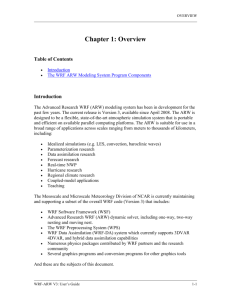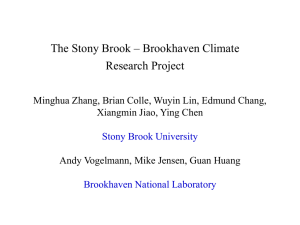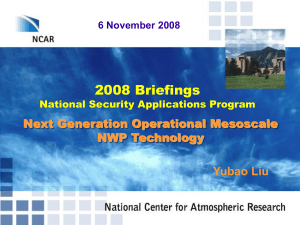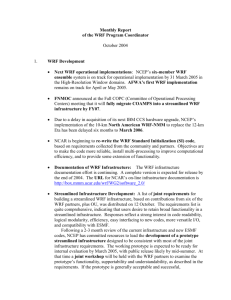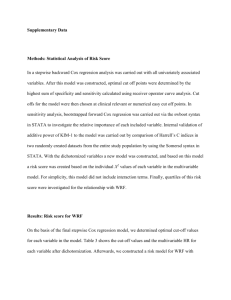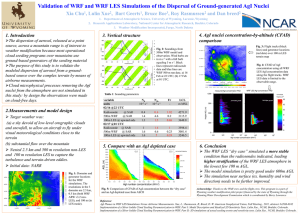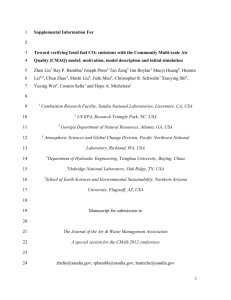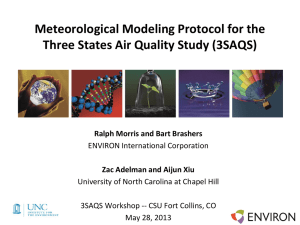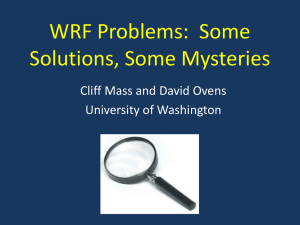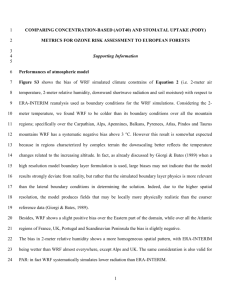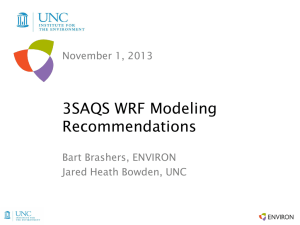Chapter 1: Overview
advertisement
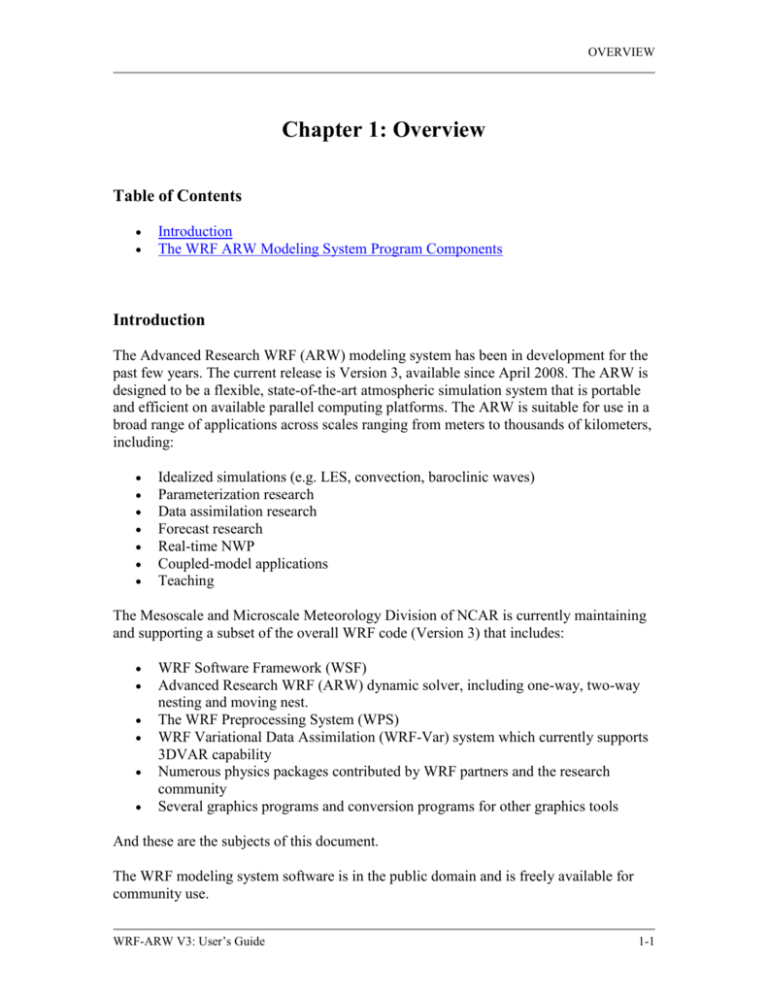
OVERVIEW Chapter 1: Overview Table of Contents Introduction The WRF ARW Modeling System Program Components Introduction The Advanced Research WRF (ARW) modeling system has been in development for the past few years. The current release is Version 3, available since April 2008. The ARW is designed to be a flexible, state-of-the-art atmospheric simulation system that is portable and efficient on available parallel computing platforms. The ARW is suitable for use in a broad range of applications across scales ranging from meters to thousands of kilometers, including: Idealized simulations (e.g. LES, convection, baroclinic waves) Parameterization research Data assimilation research Forecast research Real-time NWP Coupled-model applications Teaching The Mesoscale and Microscale Meteorology Division of NCAR is currently maintaining and supporting a subset of the overall WRF code (Version 3) that includes: WRF Software Framework (WSF) Advanced Research WRF (ARW) dynamic solver, including one-way, two-way nesting and moving nest. The WRF Preprocessing System (WPS) WRF Variational Data Assimilation (WRF-Var) system which currently supports 3DVAR capability Numerous physics packages contributed by WRF partners and the research community Several graphics programs and conversion programs for other graphics tools And these are the subjects of this document. The WRF modeling system software is in the public domain and is freely available for community use. WRF-ARW V3: User’s Guide 1-1 OVERVIEW The WRF Modeling System Program Components The following figure shows the flowchart for the WRF Modeling System Version 3. As shown in the diagram, the WRF Modeling System consists of these major programs: The WRF Preprocessing System (WPS) WRF-Var ARW solver Post-processing & Visualization tools WPS This program is used primarily for real-data simulations. Its functions include 1) defining simulation domains; 2) interpolating terrestrial data (such as terrain, landuse, and soil types) to the simulation domain; and 3) degribbing and interpolating meteorological data from another model to this simulation domain. Its main features include: GRIB 1/2 meteorological data from various centers around the world WRF-ARW V3: User’s Guide 1-2 OVERVIEW Map projections for 1) polar stereographic, 2) Lambert-Conformal, 3) Mercator and 4) latitude-longitude Nesting User-interfaces to input other static data as well as met data WRF-Var This program is optional, but can be used to ingest observations into the interpolated analyses created by WPS. It can also be used to update WRF model's initial condition when WRF model is run in cycling mode. Its main features are as follows. It is based on incremental variational data assimilation technique Conjugate gradient method is utilized to minimized the cost function in analysis control variable space Analysis is performed on un-staggered Arakawa A-grid Analysis increments are interpolated to staggered Arakawa C-grid and it gets added to the background (first guess) to get final analysis at WRF-model grid Conventional observation data input may be supplied both in ASCII or “PREPBUFR” format via “obsproc” utility Multiple radar data (reflectivity & radial velocity) input is supplied through ASCII format Horizontal component of the background (first guess) error is represented via recursive filter (for regional) or power spectrum (for global). The vertical component is applied through projections on climatologically generated averaged eigenvectors and its corresponding eigenvalues Horizontal and vertical background errors are non-separable. Each eigen vector has its own horizontal climatologically determined length scale Preconditioning of background part of the cost function is done via control variable transform U defined as B= UUT It includes “gen_be” utility to generate the climatological background error covariance estimate via the NMC-method or ensemble perturbations A utility program to update WRF boundary condition file after WRF-Var ARW Solver This is the key component of the modeling system, which is composed of several initialization programs for idealized, and real-data simulations, and the numerical integration program. It also includes a program to do one-way nesting. The key feature of the WRF model includes: Fully compressible nonhydrostatic equations with hydrostatic option Regional and global applications Complete coriolis and curvature terms Two-way nesting with multiple nests and nest levels One-way nesting WRF-ARW V3: User’s Guide 1-3 OVERVIEW Moving nests Mass-based terrain following coordinate Vertical grid-spacing can vary with height Map-scale factors for these projections: o polar stereographic (conformal) o Lambert-conformal o Mercator (conformal) o Latitude and longitude which can be rotated Arakawa C-grid staggering Runge-Kutta 2nd and 3rd order time integration options Scalar-conserving flux form for prognostic variables 2nd to 6th order advection options (horizontal and vertical) Monotonic transport and positive-definite advection option for moisture, scalar and TKE Time-split small step for acoustic and gravity-wave modes: o small step horizontally explicit, vertically implicit o divergence damping option and vertical time off-centering o external-mode filtering option Upper boundary aborption and Rayleigh damping Lateral boundary conditions o idealized cases: periodic, symmetric, and open radiative o real cases: specified with relaxation zone Full physics options for land-surface, planetary boundary layer, atmospheric and surface radiation, microphysics and cumulus convection Grid analysis nudging using separate upperair and surface data and observation nudging Spectral nudging Digital filter initialization Gravity wave drag A number of idealized examples Graphics and Verification Tools Several programs are supported, including RIP4 (based on NCAR Graphics), NCAR Graphics Command Language (NCL), and conversion programs for other readily available graphics packages: GrADS and Vis5D. Program VAPOR, Visualization and Analysis Platform for Ocean, Atmosphere, and Solar Researchers (http://www.vapor.ucar.edu/), is a 3-dimensional data visualization tool, and it is developed and supported by the VAPOR team at NCAR (vapor@ucar.edu). Program MET, Model Evaluation Tools (http://www.dtcenter.org/met/users/), is developed and supported by the Developmental Testbed Center at NCAR (met_help@ucar.edu). The details of these programs are described more in the chapters in this user's guide. WRF-ARW V3: User’s Guide 1-4
